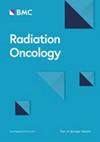A multifunctional targeted nano-delivery system with radiosensitization and immune activation in glioblastoma
IF 3.3
2区 医学
Q2 ONCOLOGY
引用次数: 0
Abstract
Glioblastoma (GBM), the most common primary brain malignancy in adults, is notoriously difficult to treat due to several factors: tendency to be radiation resistant, the presence of the blood brain barrier (BBB) which limits drug delivery and immune-privileged status which hampers effective immune responses. Traditionally, high-dose irradiation (8 Gy) is known to effectively enhance anti-tumor immune responses, but its application is limited by the risk of severe brain damage. Currently, conventional dose segmentation (2 Gy) is the standard radiotherapy method, which does not fully exploit the potential of high-dose irradiation for immune activation. The hypothesis of our study posits that instead of directly applying high doses of radiation, which is risky, a strategy could be developed to harness the immune-stimulating benefits of high-dose irradiation indirectly. This involves using nanoparticles to enhance antigen presentation and immune responses in a safer manner. Angiopep-2 (A2) was proved a satisfactory BBB and brain targeting and Dbait is a small molecule that hijack DNA double strand break damage (DSB) repair proteins to make cancer cells more sensitive to radiation. In view of that, the following two nanoparticles were designed to combine immunity of GBM, radiation resistance and BBB innovatively. One is cationic liposome nanoparticle interacting with Dbait (A2-CL/Dbait NPs) for radiosensitization effect; the other is PLGA-PEG-Mal nanoparticle conjugated with OX40 antibody (A2-PLGA-PEG-Mal/anti-OX40 NPs) for tumor-derived protein antigens capture and optimistic immunoregulatory effect of anti-OX40 (which is known to enhance the activation and proliferation T cells). Both types of nanoparticles showed favorable targeting and low toxicity in experimental models. Specifically, the combination of A2-CL/Dbait NPs and A2-PLGA-PEG-Mal/anti-OX40 NPs led to a significant extension in the survival time and a significant tumor shrinkage of mice with GBM. The study demonstrates that combining these innovative nanoparticles with conventional radiotherapy can effectively address key challenges in GBM treatment. It represents a significant step toward more effective and safer therapeutic options for GBM patients.对胶质母细胞瘤具有放射增敏和免疫激活作用的多功能靶向纳米递送系统
胶质母细胞瘤(GBM)是成人中最常见的原发性脑部恶性肿瘤,其治疗难度可想而知,原因有几个:抗辐射倾向、血脑屏障(BBB)的存在限制了药物的输送以及免疫特权地位阻碍了有效的免疫反应。传统上,高剂量照射(8 Gy)可有效增强抗肿瘤免疫反应,但其应用受到严重脑损伤风险的限制。目前,传统的剂量分割(2 Gy)是标准的放射治疗方法,但这并不能充分发挥高剂量照射激活免疫的潜力。我们研究的假设是,与其直接应用高剂量辐射(这是有风险的),不如开发一种策略,间接利用高剂量照射的免疫刺激益处。这包括使用纳米粒子以更安全的方式增强抗原呈递和免疫反应。Angiopep-2(A2)被证明是一种令人满意的 BBB 和脑靶向药物,而 Dbait 是一种小分子,能劫持 DNA 双股断裂损伤(DSB)修复蛋白,使癌细胞对辐射更敏感。有鉴于此,我们设计了以下两种纳米颗粒,创新性地将 GBM 免疫、抗辐射和 BBB 结合在一起。一种是与 Dbait 相互作用的阳离子脂质体纳米粒子(A2-CL/Dbait NPs),具有放射增敏作用;另一种是与 OX40 抗体共轭的 PLGA-PEG-Mal 纳米粒子(A2-PLGA-PEG-Mal/anti-OX40 NPs),可捕获肿瘤衍生蛋白抗原,并优化抗 OX40(已知可增强 T 细胞的活化和增殖)的免疫调节作用。这两种纳米粒子在实验模型中都表现出良好的靶向性和低毒性。具体来说,A2-CL/Dbait NPs 和 A2-PLGA-PEG-Mal/anti-OX40 NPs 的组合能显著延长 GBM 小鼠的生存时间,并使肿瘤明显缩小。这项研究表明,将这些创新纳米粒子与传统放疗相结合,可以有效解决 GBM 治疗中的关键难题。这标志着我们朝着为 GBM 患者提供更有效、更安全的治疗方案迈出了重要一步。
本文章由计算机程序翻译,如有差异,请以英文原文为准。
求助全文
约1分钟内获得全文
求助全文
来源期刊

Radiation Oncology
ONCOLOGY-RADIOLOGY, NUCLEAR MEDICINE & MEDICAL IMAGING
CiteScore
6.50
自引率
2.80%
发文量
181
审稿时长
3-6 weeks
期刊介绍:
Radiation Oncology encompasses all aspects of research that impacts on the treatment of cancer using radiation. It publishes findings in molecular and cellular radiation biology, radiation physics, radiation technology, and clinical oncology.
 求助内容:
求助内容: 应助结果提醒方式:
应助结果提醒方式:


